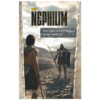If God created a perfect world at the beginning and animals were first designed as vegetarians, how did defense and attack structures like fangs and claws come about? There are two primary perspectives on this topic, so we’ll briefly review each.
The first is that these features were not originally used for carnivory. In other words, the design was the same but the function was different. Take sharp teeth, for example. Panda bears have sharp teeth, but 99% of their diet is bamboo.[i] The same is true for numerous other creatures that appear to be vicious meat-eaters, but have a primarily vegetarian diet.

Animals don’t use their large canine teeth just to eat meat. They are also used in communication. For example, many apes, dogs, cats, and other animals expose their canines to express dominance, ownership of mates, and guard territory. The same teeth that are used by wolves for killing and eating are used by dogs today for eating domestic dog food. Even sharp claws that are used today for predation are used in many cases for climbing and defense. So, this first view avoids suggesting that God’s initial design features were intended to be harmful to other creatures in His creation.
One of the limitations with this first viewpoint is that it excludes animals from changes that the Fall certainly introduced to the other parts of Creation, such as thorns and thistles being introduced to plants. Genesis 3:17–19 is clear that plants were cursed by man’s Fall with thorns and thistles, and plants use thorns primarily as a defense mechanism. Were animals exempt from similar changes that were introduced by the Fall?
The second viewpoint is that defense and attack features were introduced by God as a result of the Fall. However, it is not a widely-held Biblical Creation position that animals quickly and recently developed all physical features used for predation. This is because physical change was not required to make plant-eaters into meat-eaters. It was merely a change in behavior. We see this happen today when captive plant eaters suddenly eat their cage-mates. Many of the features that animals use for predation also help them eat plants. Also, many predators must learn to kill, as many social predators like lions are not born with the knowledge of how to hunt and kill. Instead, other animals in their group must teach them. Biblical Creationist and Biologist, Dr. Nathaniel Jeanson addresses this:
How did these big cats acquire their sharp teeth? At the Curse, God probably didn’t speak sharp teeth into existence out of nothing. His acts of global creation were finished by day seven of the creation week (Genesis 2:1–3; Exodus 20:11; Hebrews 4:3). So where did the lion’s teeth come from? … God may have created creatures with latent genetic information to be “switched on” only after Genesis 3, a concept similar to the “mediated design” model. Alternatively, God may have created anatomical and physiological features capable of multiple purposes. Powerful jaws, now used to kill and tear flesh, may have initially been used to open fruits and plant seeds of the size and hardness of modern watermelons and coconuts. Could the lion’s teeth have been used for tearing tough plants and roots in the beginning? Biblically, this latter hypothesis is compelling. Consider the effects of the reversal of the Curse in Isaiah 11:6–7: ‘The wolf also shall dwell with the lamb, and the leopard shall lie down with the kid; and the calf and the young lion and the fatling together…the lion shall eat straw like the ox.’ In reversing the Curse, God doesn’t seem to change the lion’s anatomy; He simply changes the lion’s behavior. Furthermore, Scripture explicitly mentions God switching the mental states of animals after the Flood (Genesis 9:2). Might He also have done something much like this at the Curse?[ii] (emphasis added)
[i] World Wide Fund for Nature, “What do Pandas eat? The simple answers is: bamboo,” Pando.org: www.wwf.panda.org/what_we_do/endangered_species/giant_panda/panda/what_do_pandas_they_eat/ (February 13, 2017).
[ii] Nathaniel T. Jeanson, “Did Lions Roam the Garden of Eden?” ICR.org: www.icr.org/article/did-lions-roam-garden-eden/ (February 13, 2017).








